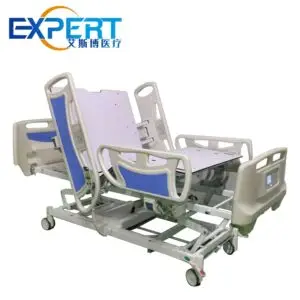Адрес
304 North Cardinal St.
Дорчестер-центр, Массачусетс 02124
Часы работы
С понедельника по пятницу: с 7:00 до 19:00.
Выходные: 10.00 - 17.00
Адрес
304 North Cardinal St.
Дорчестер-центр, Массачусетс 02124
Часы работы
С понедельника по пятницу: с 7:00 до 19:00.
Выходные: 10.00 - 17.00

The hospital patient bed is a fundamental piece of medical equipment that significantly influences patient care and outcomes
Добро пожаловать в мой блог!
Прежде чем мы погрузимся в контент, я бы хотел, чтобы вы присоединились ко мне на моих платформах социальных сетей, где я делюсь большим количеством идей, взаимодействую с сообществом и публикую обновления. Вот как вы можете связаться со мной:
Фейсбук:https://www.facebook.com/profile.php?id=100071234835011
LinkedIn:https://www.linkedin.com/company/74943205/admin/dashboard/
Ютуб:www.youtube.com/@shandongexpertmedicalequip4695
ТикТок:www.tiktok.com/@expertmedical
Теперь давайте начнем наше путешествие вместе. Надеюсь, вы найдете здесь контент проницательным, интересным и ценным.

The hospital patient bed is a fundamental piece of medical equipment that significantly influences patient care and outcomes. Beyond providing a surface for rest, hospital patient beds are designed with advanced features to enhance patient comfort, safety, and mobility. From preventing pressure ulcers to facilitating medical procedures, the role of hospital patient beds in modern healthcare is indispensable.
The evolution of hospital patient bed design has been driven by a number of factors, including:


Hospital patient beds have come a long way since their early iterations. Modern beds incorporate advanced technology and design elements to enhance patient comfort and safety. Some of the key features of contemporary patient beds include:
Pressure ulcers, also known as bedsores, develop when there is prolonged pressure on the skin, cutting off the blood supply to the underlying tissues. Pressure ulcers can be painful, slow to heal, and can lead to serious complications such as infection and sepsis.
Hospital patient beds equipped with pressure redistribution technology significantly reduce the risk of pressure ulcer development. By evenly distributing the patient’s weight and reducing shear forces, these beds protect the skin and underlying tissues. Additionally, many modern patient beds have features that allow healthcare providers to easily reposition patients, further reducing the risk of pressure ulcer formation.









Patient mobility is crucial for preventing complications such as deep vein thrombosis, pneumonia, and muscle atrophy. Hospital patient beds facilitate patient mobility by providing a stable base for transfers and incorporating features that promote active movement. Side rails offer support during transfers, while overhead lifts assist with patient repositioning.
Encouraging patient mobility can also help to improve patient morale and reduce the risk of depression and anxiety. When patients are able to move around independently, they feel more in control of their situation and less isolated. Additionally, mobility can help to improve appetite, sleep, and overall well-being.
Patient satisfaction is a key indicator of healthcare quality. The comfort and functionality of hospital patient beds directly impact patient satisfaction. Patients who are comfortable and well-supported in their beds are more likely to report positive experiences and are less likely to develop complications.
A comfortable patient bed can also contribute to a more positive patient experience by providing a sense of security and well-being. When patients are able to rest comfortably, they are more likely to heal faster and recover more quickly. Additionally, a comfortable bed can help to reduce pain and anxiety, leading to improved patient outcomes.
Hospital patient beds represent a significant investment for healthcare facilities. However, high-quality beds offer long-term cost benefits by reducing the incidence of pressure ulcers, hospital-acquired infections, and other complications. This leads to shorter hospital stays, reduced readmission rates, and lower overall healthcare costs.
Additionally, high-quality hospital patient beds can improve patient outcomes, leading to shorter hospital stays and reduced readmission rates. This can result in significant cost savings for healthcare facilities. For example, a study published in the Journal of Clinical Nursing found that the use of pressure-relieving mattresses can reduce the incidence of pressure ulcers, leading to significant cost savings.

| Характерная черта | Преимущества |
|---|---|
| Height adjustability | Improves ergonomics for healthcare providers, reduces back injuries, facilitates patient care |
| Trendelenburg and reverse Trendelenburg positioning | Aids in venous return, relieves respiratory distress, facilitates medical procedures |
| Pressure redistribution | Prevents pressure ulcers, improves skin integrity, enhances patient comfort |
| Built-in scales | Facilitates accurate weight monitoring, aids in fluid balance management, supports nutritional therapy |
| Side rails | Provides support during transfers, enhances patient safety, reduces the risk of falls |
| Overhead lifts | Assists with patient repositioning, promotes mobility, reduces the physical strain on healthcare workers |
The hospital patient bed is more than just a piece of furniture; it is a critical component of the healthcare environment. By understanding the impact of patient beds on patient outcomes, healthcare providers can make informed decisions about the selection and use of these devices. As technology continues to advance, we can expect to see even more innovative patient beds that enhance patient care and improve overall healthcare outcomes.
Как часто следует hospital patient beds be cleaned and disinfected?
Hospital patient beds should be cleaned and disinfected frequently to prevent the spread of infection. Regular cleaning and disinfection are essential for maintaining a clean and hygienic environment for patients.
What is the difference between a medical bed and a hospital patient bed?
While often used interchangeably, hospital patient beds are typically more advanced and designed to meet the specific needs of hospitalized patients. Medical beds, on the other hand, may have fewer features and are often used in home care settings.
What is the role of nursing staff in preventing pressure ulcers related to hospital patient beds?
Nursing staff play a crucial role in preventing pressure ulcers by regularly assessing patients, repositioning them, and using appropriate pressure-relieving devices on hospital patient beds. Nurses should also educate patients and their families about the importance of pressure ulcer prevention.